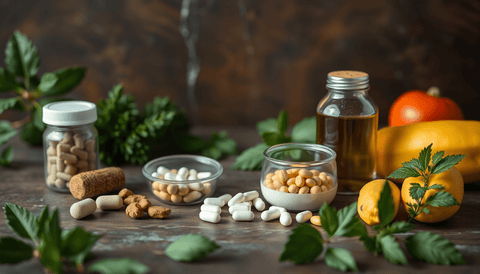Introduction
In recent years, the popularity of natural supplements has surged as more individuals aim to enhance their health and wellness in a proactive, holistic manner. From vitamins and minerals to herbal extracts and specialty nutrients, these products are now common fixtures in medicine cabinets and gyms alike. The rising trend reflects a desire for more "natural" and "clean" options, driven by a growing awareness of the importance of preventative health, as well as skepticism towards synthetic pharmaceuticals. However, with a vast array of products flooding the market, consumers often face the challenge of distinguishing high-quality, effective supplements from those that are less trustworthy or misleading.
Understanding supplement labels is essential to making informed, safe, and effective health choices. Labels are more than just marketing tools; they are a primary source of vital information about what a product contains, how it was sourced, and what claims are being made—many of which are subject to regulation. Unfortunately, many consumers lack the knowledge needed to interpret this information accurately, risking purchases based on misleading claims or inadequate ingredient information. Misinterpretation can lead to ineffective supplementation, potential adverse effects, or simply wasted money.
The purpose of this comprehensive guide is to demystify natural supplement labels, providing you with the tools and knowledge necessary to decode the language, verify ingredients, assess claims, and choose products that truly support your health and well-being. Whether you are new to supplementation or a seasoned user seeking to refine your choices, this post aims to empower you to navigate labels confidently, ensuring your health investments are both safe and effective.
I. Understanding Natural Supplement Labels: What You Need to Know About Labeling Regulations and Information
Before diving into the specifics of label reading, it’s crucial to understand what constitutes a "natural" supplement and the regulatory frameworks that oversee their labeling. The term "natural" is often used loosely in marketing, but legally, it isn’t strictly defined by standard agencies like the Food and Drug Administration (FDA) or the Federal Trade Commission (FTC). Generally, a "natural" supplement refers to products derived from natural sources—plants, minerals, or animal products—processed minimally to retain their inherent properties. However, the lack of a universal legal definition means that the term can sometimes be used in a misleading way, emphasizing transparency and verification. The regulation of supplement labeling is primarily governed by the Dietary Supplement Health and Education Act (DSHEA) of 1994, which established the framework for defining, labeling, and marketing dietary supplements. Under DSHEA, supplements are classified separately from drugs and foods, which means they are not subjected to pre-market approval but must comply with specific manufacturing and labeling standards. Both the FTC and FDA play vital roles: the FDA monitors safety and enforces regulations, while the FTC oversees truthful advertising claims. Common terms on labels like "all-natural," "organic," "non-GMO," or "free from artificial additives" serve as indicators of product qualities and sourcing. While these terms provide useful hints, they are often unregulated unless linked to specific certifications. For example, "organic" requires certification by a licensed authority, offering consumers more confidence in the authenticity. Similarly, "non-GMO" labels indicate the absence of genetically modified organisms, verified through third-party certification. A comprehensive label generally features several key components: - The **Supplement Facts panel**, which lists serving size, quantities of nutrients or ingredients, and daily value percentages. - The **ingredients list**, detailing every component included in the product, usually arranged in descending order of quantity. - Any **health claims** or **disclaimers**, which must adhere to regulatory standards and are often accompanied by asterisks or small print. - Contact information and manufacturer details, essential for tracing quality or obtaining further information. Skimming and reviewing each of these sections before purchase is critical to ensure the product aligns with your health goals and safety standards. A thoughtful review can help you avoid unnecessary fillers, artificial substances, or potentially contaminated products, enabling you to make the most of your health investments.
II. Supplement Label Interpretation: Decoding the Language and Terminology Used on Labels
One of the most critical skills in maximizing your health choices is learning how to accurately interpret supplement labels. The supplement facts panel provides essential information, but understanding its layout and terminology helps you make meaningful comparisons between products. The panel typically includes serving size, servings per container, and a list of active ingredients with their respective amounts. The key metrics to observe here are the potency—how much of each active ingredient is present—and the percentage of daily values, which indicate how much of a recommended intake the product provides per serving. When reading the ingredients list, pay close attention to the order of components. Ingredients are listed from highest to lowest quantity, so the first few items represent the main constituents of the supplement. Recognizing specific terminologies such as "extract," "powder," "concentrate," or "standardized extract" can inform you about the potency and form of the ingredient. For instance, a *standardized botanical extract* indicates that the extract contains a specific percentage of active compounds, providing consistent dosing and efficacy. Proprietary blends are common in supplements—these combine multiple ingredients under a shared name without revealing individual quantities. While some blends can be legitimate, they often obscure how much of each component you’re actually ingesting. Always assess whether the blend's total weight aligns with your health goals and be cautious if the label lacks transparency. Health claims on labels—such as "supports immune health" or "enhances energy"—are regulated but can sometimes be misleading if taken out of context. The FDA permits structure/function claims provided that they include disclaimers stating the claim is not evaluated by the agency. Be wary of exaggerated language suggesting the supplement can cure, mitigate, or prevent disease, which is prohibited unless authorized by regulatory agencies. To spot potential red flags and misleading language, look for vague terms like "natural," "pure," or "scientifically formulated" without verification, or labels that heavily emphasize marketing language over substantive ingredient information. Always cross-reference claims with reputable scientific sources or consult health professionals when in doubt. The more informed you are about language and terminology, the better equipped you’ll be in selecting supplements that genuinely support your health rather than falling prey to clever marketing tactics.
III. Identifying Natural Ingredients: Recognizing Authentic and High-Quality Components
The foundation of a genuinely beneficial supplement lies in the quality and authenticity of its ingredients. Distinguishing between natural, synthetic, and processed components ensures that you’re getting a product aligned with your health values and goals. Natural ingredients derive directly from botanical, mineral, or animal sources and retain their inherent properties through minimal processing. In contrast, synthetic ingredients are created chemically and may not offer the same bioavailability or safety profile. To verify the natural origin of ingredients, scrutinize the label for botanical names, sourcing origin information, and certifications. Latin plant names, such as *Curcuma longa* for turmeric or *Panax ginseng* for ginseng, provide clarity around the botanical source. Sourcing information, although sometimes limited on the label, can often be found on the manufacturer’s website or upon request, revealing whether ingredients are ethically sourced, sustainably harvested, or wildcrafted. Certified organic ingredients are a strong indicator of natural purity, free from synthetic pesticides, fertilizers, and additives. Look for USDA Organic or equivalent certification seals, which are generally a sign of strict standards and rigorous inspection processes. Third-party testing seals, such as those from USP (United States Pharmacopeia) or NSF International, further endorse the quality and purity of the ingredients, confirming that they meet established standards for potency and safety. Indicators of quality extend beyond certification; they include manufacturing quality controls, such as batch testing for contaminants, heavy metals, or microbial contamination. Reputable brands often provide transparency through Certificates of Analysis (COA), available upon request or posted online. Avoid products that contain artificial flavorings, fillers, or unnecessary additives, as these dilutes the natural integrity of the product and may introduce potential allergens or contaminants. In essence, authentic natural ingredients are characterized by transparency, reputable sourcing, and certification. These factors ensure that what you’re ingesting is of high quality, aligning with your health and ethical considerations.
IV. Deciphering Supplement Claims: Separating Fact from Fiction
Health claims on supplement labels are a common source of confusion and can sometimes be misleading. These claims range from general statements like "supports immune health" to more specific assertions such as "boosts energy" or "detoxifies." While many of these claims are regulated—requiring disclaimers or evidence—they can still be made in ways that subtly exaggerate benefits or oversell the product’s capabilities. Understanding what these claims really mean involves recognizing the difference between structure/function claims and disease claims. The FDA permits structure/function claims, which describe the role of a nutrient or supplement in supporting a normal body function. For example, "calcium builds strong bones" or "Vitamin C supports immune function." These are generally acceptable, provided they include a disclaimer stating that the FDA has not evaluated the claim and that the product is not intended to diagnose, treat, cure, or prevent any disease. Claims that suggest a product can "cure" or "prevent" disease are more scrutinized. If such bold claims are present, be wary and seek further evidence—such claims are only permissible if authorized through FDA approval based on scientific substantiation. Many claims will be supported by studies cited on the label or packaging; however, it’s essential to evaluate whether the cited research is credible, peer-reviewed, and applicable to the specific product. Scientific backing and evidence are critical for credible health claims. Look for reputable studies, clinical trials, or meta-analyses backing any assertions. When evaluating claims, ask yourself: Is the claim specific and measurable? Does it specify the body system or function involved? Does it rely on anecdotal evidence or marketing hype? The key is to develop a critical perspective that scrutinizes the language and seeks out reputable sources. Recognizing exaggerated or unsupported claims involves reading between the lines. Phrases like "promotes rapid detox," "completely cures fatigue," or "guaranteed to increase energy overnight" often signal overpromising. Authentic products will honestly describe what they support without sensationalism and will include caveats or limitations based on current scientific understanding. By cultivating an informed approach to supplement claims, you can avoid scams, exaggerated promises, and ineffective products, ensuring your supplement choices are rooted in credible evidence and aligned with your health objectives.
V. Understanding Ingredient Sourcing: Tracing the Origin of Supplement Components
Ingredient sourcing is a key factor influencing the efficacy, safety, and ethical integrity of your supplements. Transparency in sourcing allows consumers to assess whether they are purchasing products derived from sustainable, ethical, and high-quality sources. A responsible manufacturer will often provide detailed information about the origins of their ingredients, whether they are cultivated domestically or imported from verified sources abroad. Domestic ingredients tend to be easier to trace back to their origins and are often subjected to stricter safety and quality controls. Conversely, imported ingredients, especially those from countries with less rigorous standards, require additional verification. Certifications like Fair Trade, Organic, or third-party verified sustainability seals ensure that sourcing practices adhere to environmentally and socially responsible standards. Certifications like USDA Organic or Ecocert indicate that raw materials have been grown and harvested under specific sustainable practices, minimizing environmental impact. Sourcing from wildcrafted or sustainably farmed sources can also influence potency and freshness, particularly for botanicals and herbs. Sourcing impact is not only environmental; it can also affect the supplement’s safety profile. For example, heavy metal contamination in certain imported herbs is a known concern, making third-party testing and certification vital. Reputable brands often provide comprehensive documentation on sourcing, including batch-specific Certificates of Analysis and supply chain transparency reports. When shopping for supplements—especially herbal extracts or omega-3 oils—look for brands that prioritize traceability and transparency. Brands committed to high sourcing standards are more likely to deliver products that are both safe and effective, giving you peace of mind in your health investments.
VI. Evaluating Supplement Quality: Ensuring Safety, Potency, and Efficacy
Quality assurance is fundamental when selecting supplements that truly support your health. High-quality products are manufactured according to strict standards, undergo rigorous testing, and provide consistent potency. To evaluate quality, examine whether the product bears certifications such as Good Manufacturing Practices (GMP), NSF International, or USP Verified seals, which attest to manufacturing integrity and quality control processes. Third-party testing is a critical component of quality assurance, verifying that each batch meets label claims for potency and is free from contaminants like heavy metals, microbes, or pesticides. Many reputable brands provide Certificates of Analysis (COA), which should be accessible and current, validating the product’s safety and efficacy. Storage conditions, expiration dates, and manufacturing dates also influence the stability and potency of supplements. Be sure to store your products as recommended—usually in cool, dry places—and verify that they are within their expiration periods. An expired product can lose potency or even become unsafe. Avoid products that display red flags, such as unverified batch testing, unclear labeling, or vague ingredient lists. When in doubt, choose brands that follow Good Manufacturing Practices (GMP) standards, as these demonstrate a commitment to consistent quality and safety. High-quality supplements can be a valuable addition to your health, but only when you select products that meet these rigorous standards.
Conclusion
Mastering the art of reading and understanding natural supplement labels is a vital step toward making informed, safe, and effective health choices. By familiarizing yourself with labeling regulations, decoding language and terminology, verifying natural and high-quality ingredients, critically evaluating health claims, and scrutinizing sourcing and manufacturing standards, you empower yourself to select products that genuinely support your wellness goals. A discerning consumer who invests time in understanding these aspects can avoid misleading marketing, potential safety hazards, and ineffective products—all while optimizing the benefits of supplementation.
Being proactive in your supplement selection process reflects a commitment to your health and well-being. Remember, knowledge isYour most potent tool—use it to navigate the vast supplement market confidently and make choices that align with your health aspirations.
Call to Action
We invite you to share your experiences with deciphering supplement labels in the comments below. Bookmark this comprehensive guide for future shopping trips and refer to trusted resources such as Topvitamine's vitamin C category or explore their line of high-quality supplements. Empower yourself to take control of your health by staying informed and vigilant—your well-being depends on it.
Q&A Section
Q1: Why is it important to understand supplement labels?
A1: Understanding supplement labels allows you to verify the ingredients, dosage, and claims made by the product. This knowledge helps you avoid misleading marketing, select high-quality products that meet your needs, and ensure safety, especially when managing health conditions or avoiding certain allergens.
Q2: What should I look for on a supplement's ingredients list?
A2: Check the order of ingredients (from most to least), look for natural botanical names, verify whether ingredients are standardized or certified, and be cautious of proprietary blends that obscure individual ingredient quantities.
Q3: How can I tell if a supplement contains natural ingredients?
A3: Look for certifications like USDA Organic, check the botanical names, source origin information, and third-party testing labels such as USP or NSF. Avoid products with artificial fillers or flavorings.
Q4: What are some red flags for misleading supplement claims?
A4: Promises of rapid cures, exaggerated benefits like "detoxifies instantly" or "guaranteed energy," vague language without scientific backing, and claims that suggest the product can prevent or treat disease without approval are red flags.
Q5: How do certifications and sourcing impact supplement quality?
A5: Certifications like GMP, NSF, or organic seals ensure that the product meets certain safety and quality standards. Transparent sourcing from sustainable and verified origins reduces risks of contamination and ensures product efficacy.
Important Keywords
- natural supplement labels
- label decoding
- health claims interpretation
- authentic ingredients
- supplement sourcing
- quality assurance
- third-party testing
- certified organic
- GMP standards
- supplement facts panel
- misleading claims



